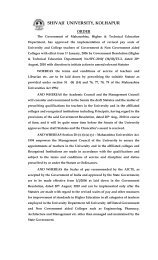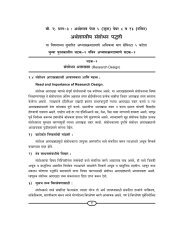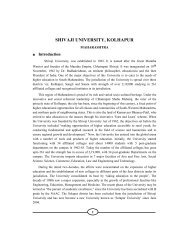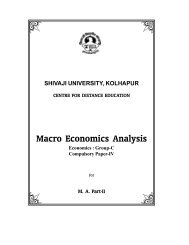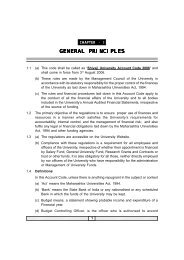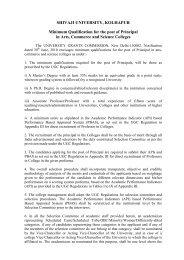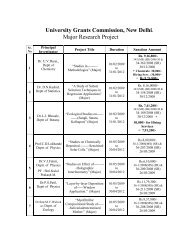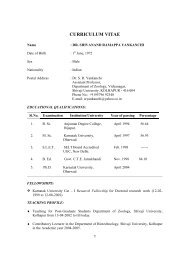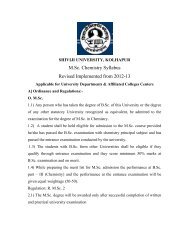Economics(Paper-4) - Shivaji University
Economics(Paper-4) - Shivaji University
Economics(Paper-4) - Shivaji University
Create successful ePaper yourself
Turn your PDF publications into a flip-book with our unique Google optimized e-Paper software.
The share of the primary sector in the under-developed countries is significantly larger<br />
an on the average, than in the group of advanced countries.<br />
2) Capital Deficiency : Capital deficiency is another characteristics which is<br />
universally applicable to all these countries. It is both a cause and an effect of<br />
underdevelopment. Generally under developed countries suffer from chronic shortage<br />
of capital which is largely responsible for low per capita income in an economy. In other<br />
words availability of capital in underdeveloped countries is very low as compared to<br />
that in well advanced countries.<br />
3) Unutilized / underutilized Natural Resources : The natural resources in an<br />
underdeveloped economy are either unutilized or under utilized. Generally speaking<br />
under developed countries are not deficient in land, water, mineral, forest or power<br />
resources, through they be untapped. In other worlds they constitute only potential<br />
resources. The main problem in their case is that such resources have not been fully<br />
and properly utilized due to various difficulties, such as their inaccessibility shortage of<br />
capital, primitive techniques, and the small extent of the market.<br />
4) General Poverty : An underdeveloped country is poverty-ridden . Poverty is<br />
mostly reflected in very low per capita. Income as compared to that of the developed<br />
countries. It is the per capita income of a country which determines whether a country<br />
is richer or poor. i.e. developed or underdeveloped. The average annual per capita<br />
income in under developed countries like India, Pakistan and Indonesia is below and<br />
whereas it is much higher in the developed countries. The extremely low GNP per<br />
capita of low-income economies reflected the extent of poverty in them. It is not relative<br />
poverty but absolute poverty that is more important in assessing such economies. The<br />
absolute poverty is reflected in low living standard of the people.<br />
5) Economic Backwardness of the people : The people in under-developed<br />
countries are economically very backward, that is the quality of the people as productive<br />
agents is low. Instead of acquiring the greatest possible control over their physical<br />
environment, the people have struck as balance with nature at an elementary level.<br />
They have been relatively unsuccessful in solving the economic problem of man’s<br />
conquest of this are low labour efficiency, factor immobility, limited specialization in<br />
occupation and a value structure and social structure that minimize the incentives for<br />
economic changes.<br />
6) Demographic Features : The underdeveloped countries are generally suffering<br />
from the problem of over population. The main demographic characteristics of these<br />
countries are - 1) Most of the underdeveloped countries are in the high population growth<br />
potential stage with high birth rate and sharp declining death rate. 2) The overage<br />
expectation of life in underdeveloped countries is much lower than that of advanced<br />
countries. 3) The percentage of economically active population is very small in<br />
123456789012345678901234567890121234567<br />
123456789012345678901234567890121234567<br />
4<br />
123456789012345678901234567890121234567<br />
123456789012345678901234567890121234567<br />
123456789012345678901234567890121234567<br />
123456789012345678901234567890121234567<br />
123456789012345678901234567890121234567<br />
123456789012345678901234567890121234567



